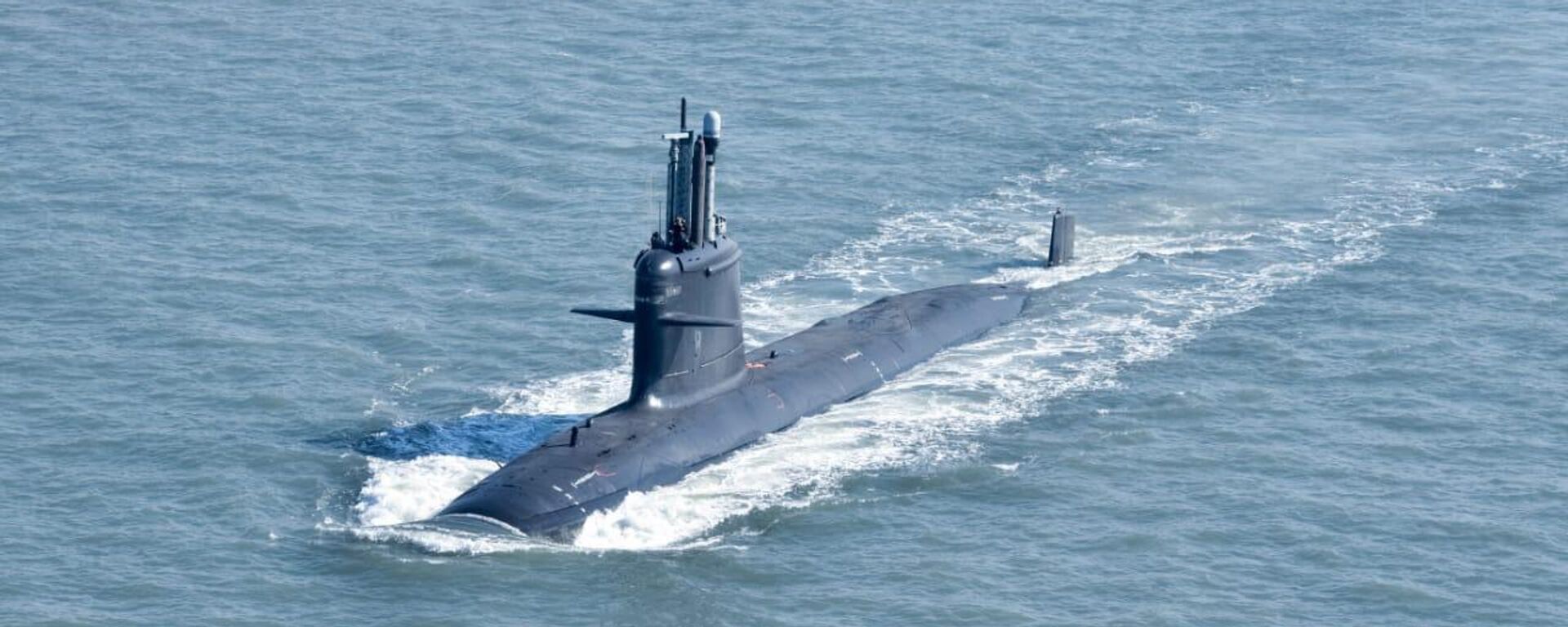https://sputniknews.in/20240813/whats-driving-the-indian-navys-ambition-for-more-nuclear-attack-submarines-8003815.html
5 Reasons Why India Needs Nuclear Attack Submarines
5 Reasons Why India Needs Nuclear Attack Submarines
Sputnik India
The SSNs are strategic underwater assets that are designed to conquer both the SSBN and the enemy in ocean waters, enhancing India's naval prowess manifold, maritime experts have said.
2024-08-13T16:32+0530
2024-08-13T16:32+0530
2024-08-14T10:32+0530
india
pakistan
indian ocean
indian navy
narendra modi
delhi
new delhi
visakhapatnam
china
submarine
https://cdn1.img.sputniknews.in/img/07e8/06/1b/7717395_109:0:3750:2048_1920x0_80_0_0_7cd5ef8721d705ed8dd6a6e5cb3ad09b.jpg
The SSNs are strategic underwater assets that are designed to conquer both the SSBN and the enemy in ocean waters, enhancing India's naval prowess manifold, maritime experts have said.Both SSN – Submersible Ship Nuclear or commonly referred to as a fast-attack submarine and SSBN – Submersible Ship Ballistic Missile Nuclear run on the power provided by nuclear reactors, Indian Navy veteran Commander (Retd) Rahul Verma explained.Primarily these submarines are designed to launch the structure of fast missiles or ballistic missiles with nuclear warheads, he emphasised. However, an SSN is designed to intercept and conquer both, the SSBN and the adversary, he noted.Meanwhile, defence analyst Girish Linganna explained in a conversation with Sputnik India the main reasons behind India's focus on building nuclear attack submarines (SSNs) are:Meanwhile, the Indian Navy is currently in possession of a lone SSBN, the indigenously developed INS Arihant, which was commissioned into service in 2016. Another SSBN named INS Arighat is currently undergoing sea trials and is set to join the nation's naval fleet later this year.Overall, the Indian Navy will have four SSBNs under its command with two more similar submarines being built in Visakhapatnam at present.Notably, India does not have an SSN in its fleet right now but the country is set to begin an over $12 billion project to build six SSNs to augment its underwater offensive capabilities, besides maintaining a credible nuclear deterrence against hostile neighbours.
https://sputniknews.in/20240701/self-reliance-government-approves-indias-new-submarine-project-7747530.html
india
pakistan
indian ocean
delhi
new delhi
visakhapatnam
china
Sputnik India
feedback.hindi@sputniknews.com
+74956456601
MIA „Rossiya Segodnya“
2024
Pawan Atri
https://cdn1.img.sputniknews.in/img/07e6/0c/13/139630_147:0:831:684_100x100_80_0_0_8fa2b25903e7787fe6a2698552c167df.png
Pawan Atri
https://cdn1.img.sputniknews.in/img/07e6/0c/13/139630_147:0:831:684_100x100_80_0_0_8fa2b25903e7787fe6a2698552c167df.png
News
en_IN
Sputnik India
feedback.hindi@sputniknews.com
+74956456601
MIA „Rossiya Segodnya“
Sputnik India
feedback.hindi@sputniknews.com
+74956456601
MIA „Rossiya Segodnya“
Pawan Atri
https://cdn1.img.sputniknews.in/img/07e6/0c/13/139630_147:0:831:684_100x100_80_0_0_8fa2b25903e7787fe6a2698552c167df.png
india ssn project, india nuclear attack submarine project, indian navy ssn, indian navy ssns, indian navy ssbn, indian navy ins arihant, ins arighat, indian navy ins arighat, ins arihant, indian navy acceptance of necessity ssn, indian navy submarine project, indian navy submarine fleet, indian navy news, indian navy ssn submarine project, indian navy nuclear submarine, indian navy nuclear-powered submarine, indian navy submarine requirement, submarine news, indian submarine news, india submarine news,
india ssn project, india nuclear attack submarine project, indian navy ssn, indian navy ssns, indian navy ssbn, indian navy ins arihant, ins arighat, indian navy ins arighat, ins arihant, indian navy acceptance of necessity ssn, indian navy submarine project, indian navy submarine fleet, indian navy news, indian navy ssn submarine project, indian navy nuclear submarine, indian navy nuclear-powered submarine, indian navy submarine requirement, submarine news, indian submarine news, india submarine news,
5 Reasons Why India Needs Nuclear Attack Submarines
16:32 13.08.2024 (Updated: 10:32 14.08.2024) Indian Navy has approached the government to grant the acceptance of necessity (AoN) to build two nuclear attack submarines (SSNs) in the country, a report on Monday said. Sputnik India analyses how India's maritime force will benefit from having these underwater vessels in its fleet.
The SSNs are strategic underwater assets that are designed to conquer both the SSBN and the enemy in ocean waters, enhancing India's naval prowess manifold, maritime experts have said.
Both SSN – Submersible Ship Nuclear or commonly referred to as a fast-attack submarine and SSBN – Submersible Ship Ballistic Missile Nuclear run on the power provided by nuclear reactors, Indian Navy veteran Commander (Retd) Rahul Verma explained.
Primarily these submarines are designed to launch the structure of fast missiles or ballistic missiles
with nuclear warheads, he emphasised. However, an SSN is designed to intercept and conquer both, the SSBN and the adversary, he noted.
"Besides, the SSN submarines have evolved into multi-mission submarines. Their roles include submarine-launched cruise missile platforms, intelligence gathering, and insertion and infiltration of Special Forces teams, in addition to the traditional hunter and killer role. They have longer endurance and high speed," Verma told Sputnik India on Tuesday.
Meanwhile, defence analyst Girish Linganna explained in a conversation with Sputnik India the main reasons behind India's focus on building nuclear attack submarines (SSNs) are:
1.
Longer Missions: SSNs can stay underwater for much longer than conventional submarines, which often need to surface to recharge. This makes them great for extended patrols.
2.
Speed and Stealth: They are faster, hence, they are able to travel quickly
and evade enemy tracking, and quieter, which makes them harder to detect.
3.
Strategic Defence: In case of increasing threats, SSNs strengthen India's ability to deter potential attacks.
4.
Technological Growth: Developing SSNs domestically helps India improve its technology in nuclear propulsion and submarine design, supporting the country's goal of self-reliance in defence.
5.
Counteracting Threats: SSNs provide India the capability of strong response to the growing presence of Chinese submarines in the Indian Ocean and advanced submarine supplies to Pakistan.
Meanwhile, the Indian Navy is currently in possession of a lone SSBN, the indigenously developed INS Arihant, which was commissioned into service in 2016.
Another SSBN named
INS Arighat is currently
undergoing sea trials and is set to join the nation's naval fleet later this year.
Overall, the Indian Navy will have four SSBNs under its command with two more similar submarines being built in Visakhapatnam at present.
Notably, India does not have an SSN in its fleet right now but the country is set to begin an over $12 billion project to build six SSNs to augment its underwater offensive capabilities, besides maintaining a credible nuclear deterrence against hostile neighbours.



